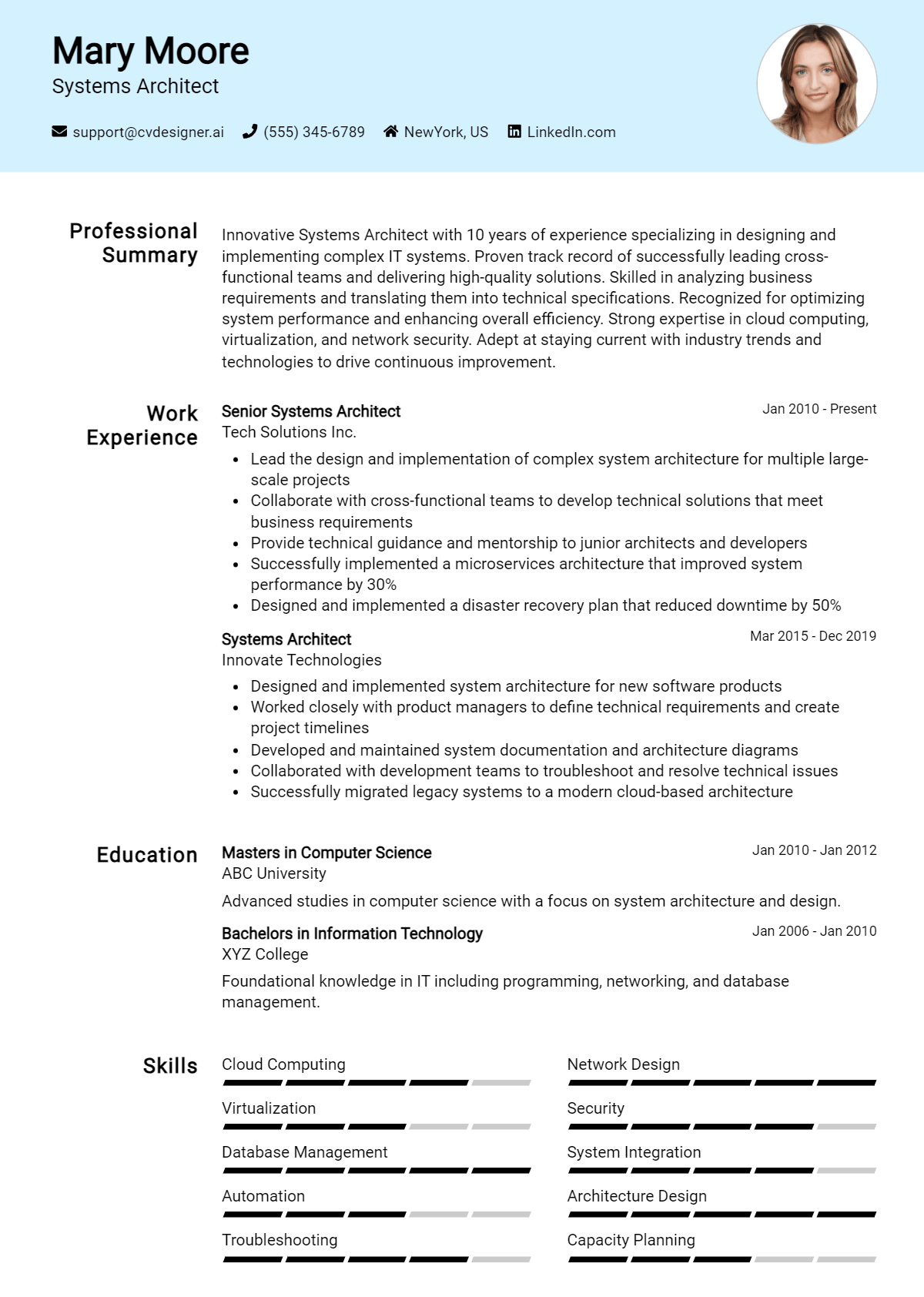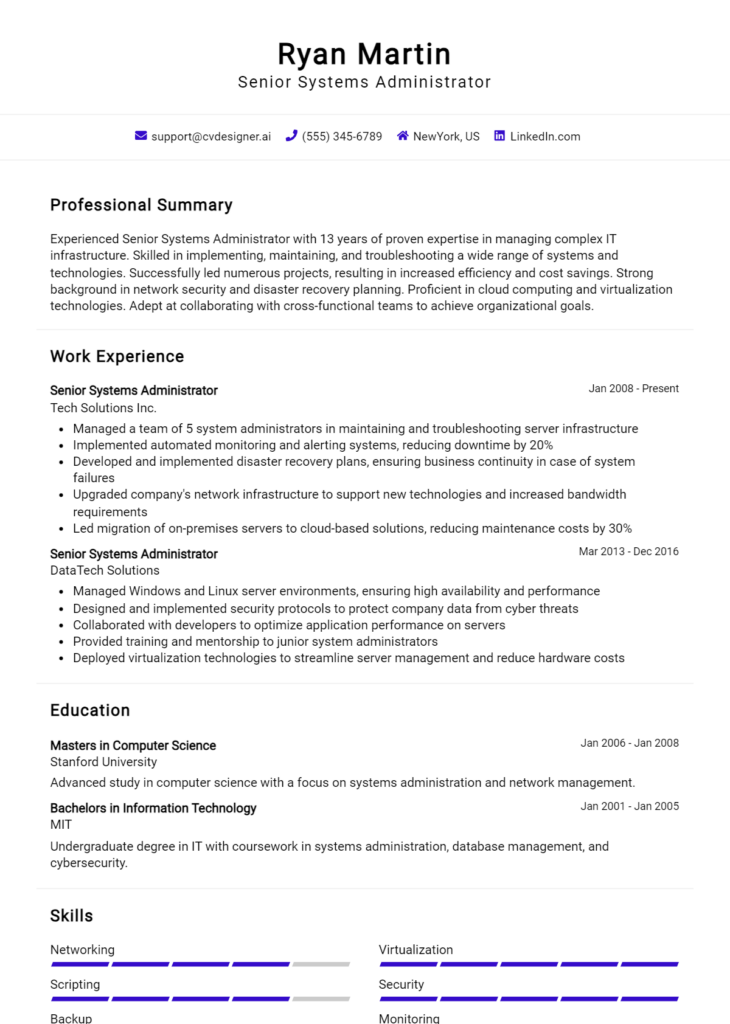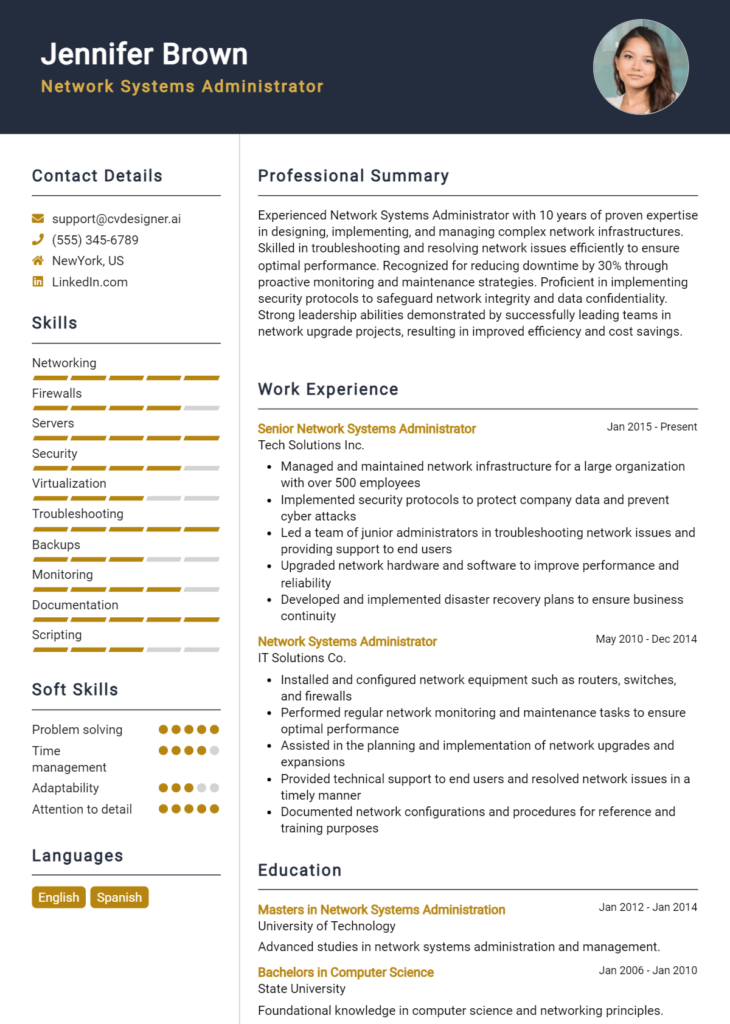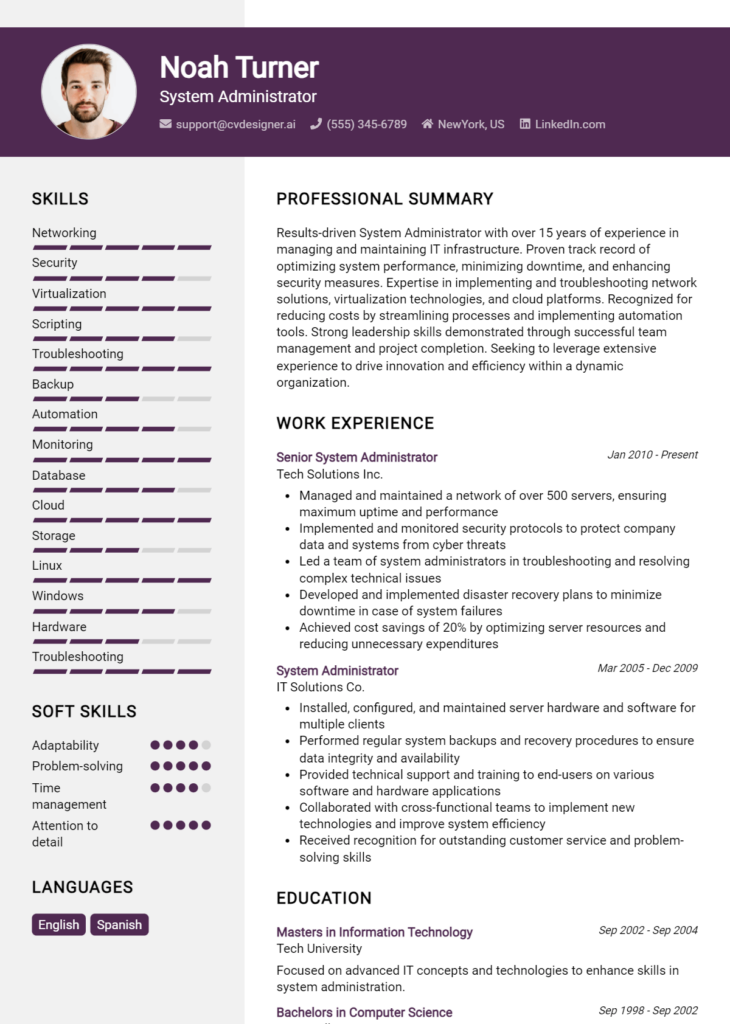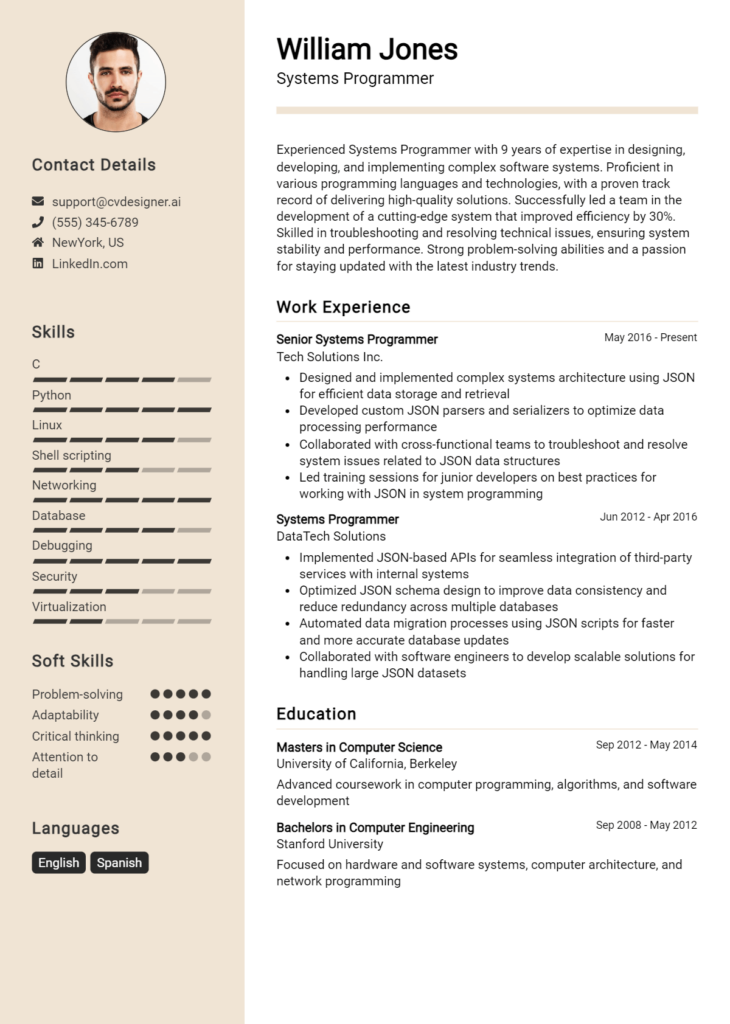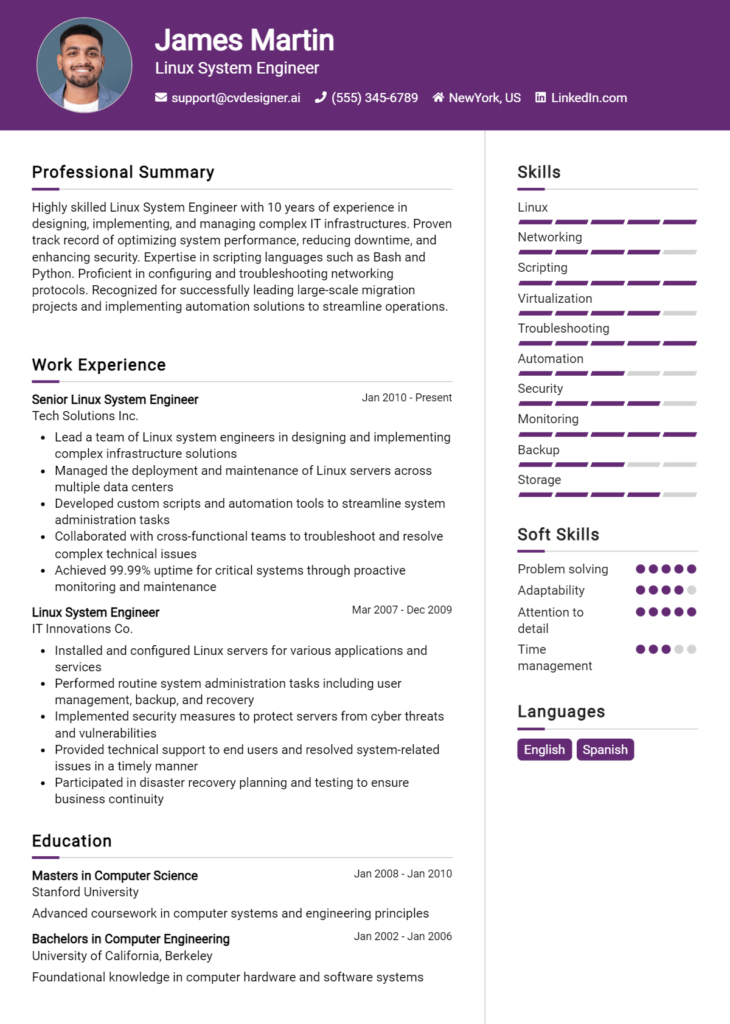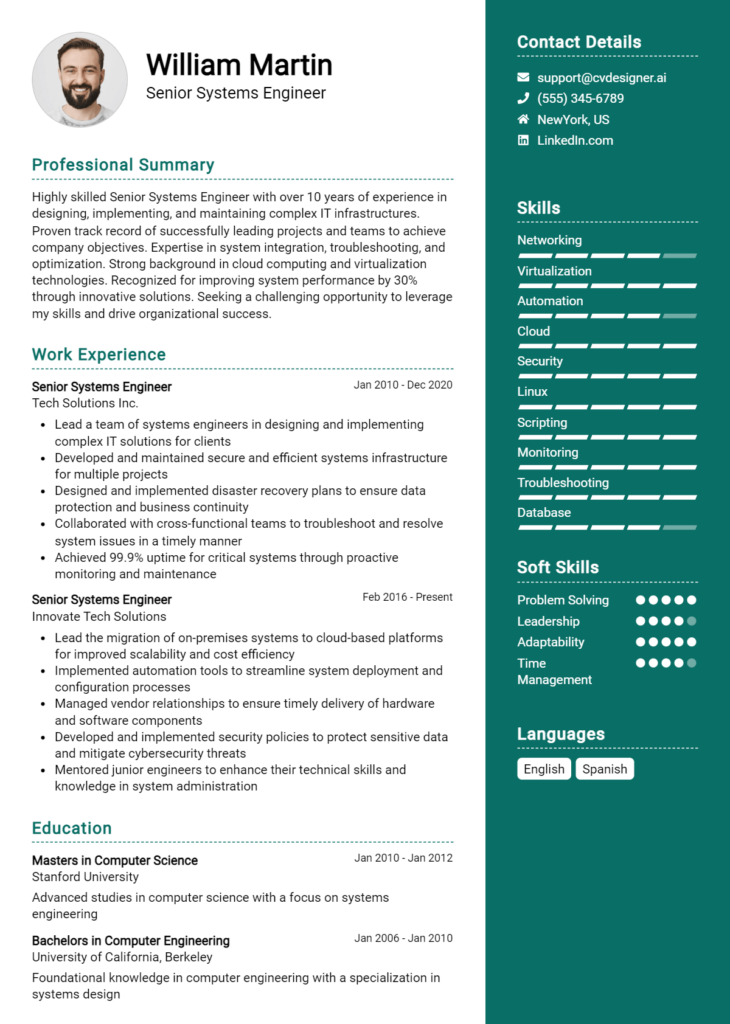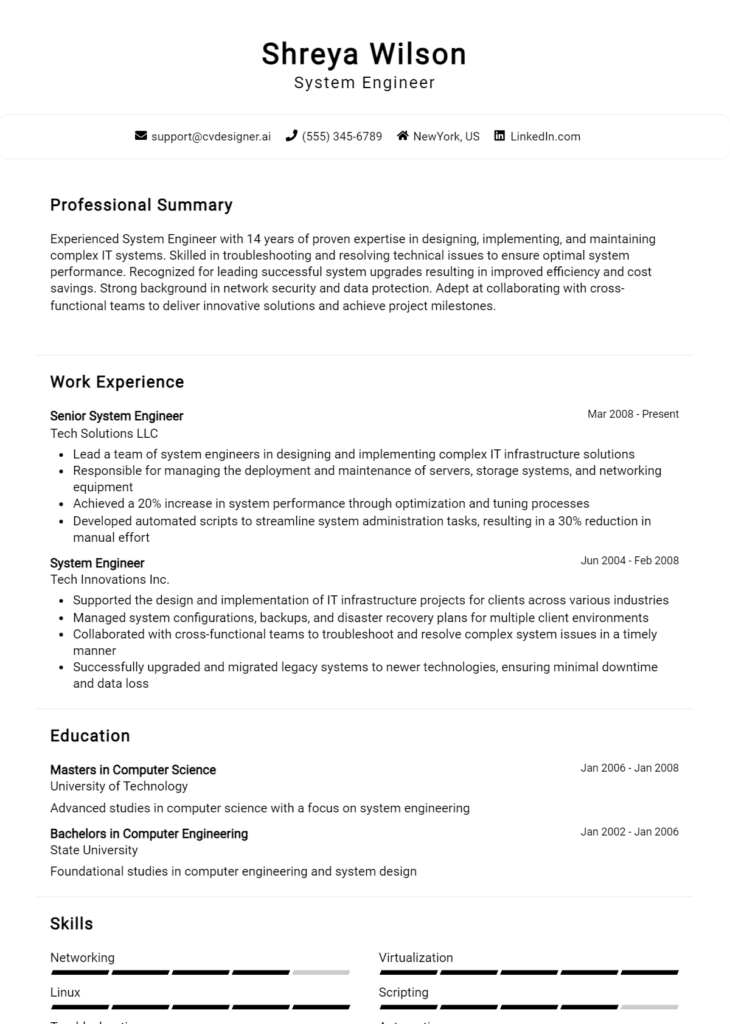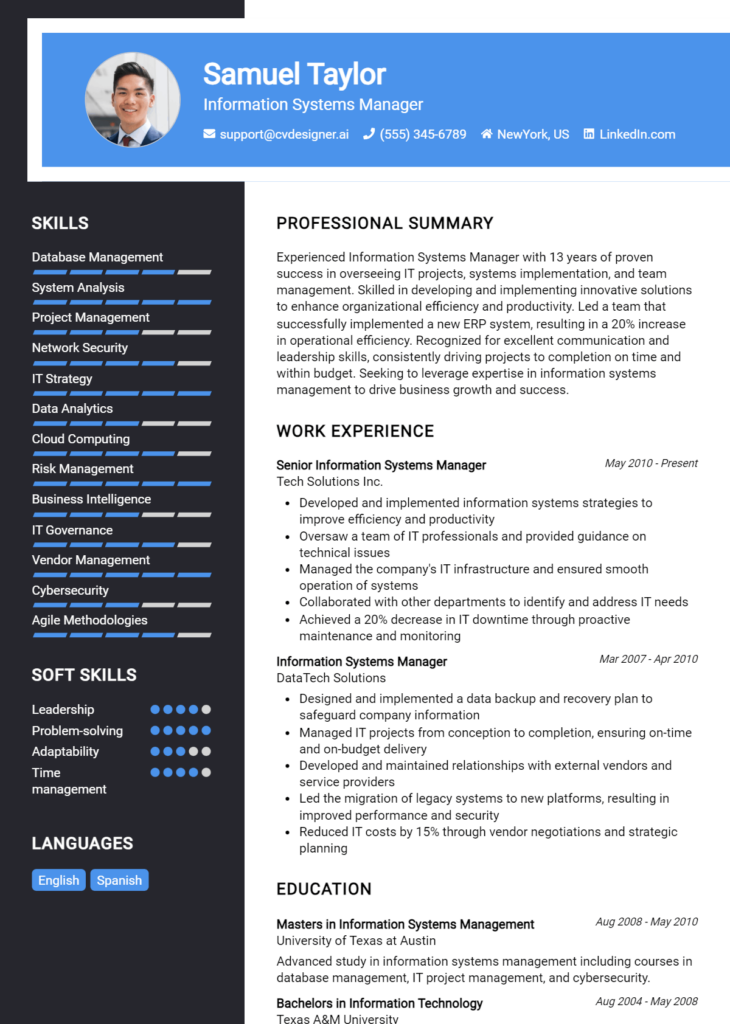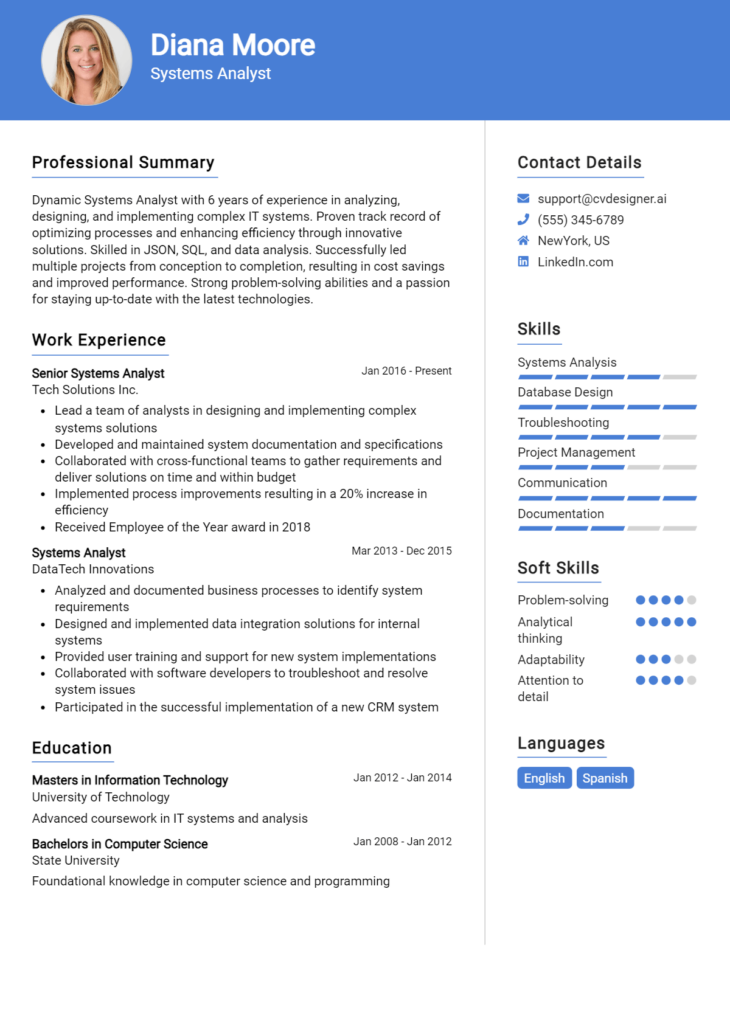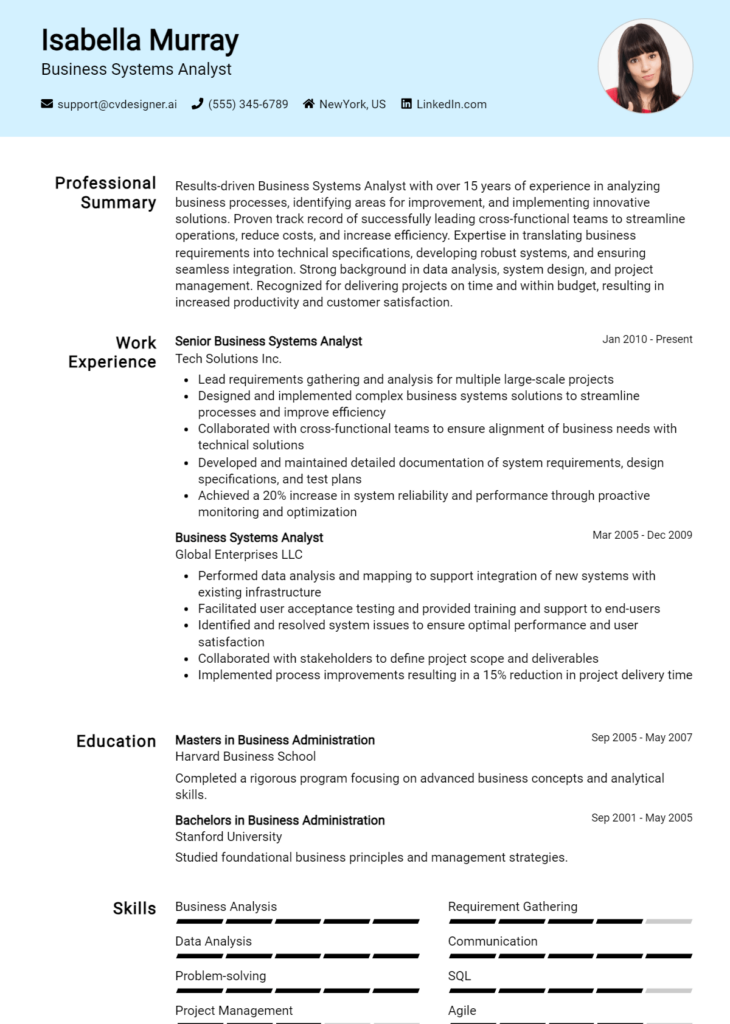Most Popular Systems Architect Resume Examples
Explore additional Systems Architect resume samples and guides and see what works for your level of experience or role.
As the backbone of any effective IT infrastructure, the role of a Systems Architect is pivotal in shaping the technology landscape of an organization. This position requires a blend of technical expertise, strategic planning, and exceptional problem-solving skills to design systems that meet business needs while ensuring scalability and security. Given the complexity and high stakes involved in this role, a well-crafted resume becomes essential to showcase your qualifications and stand out in a competitive job market. A compelling resume not only highlights your experience and achievements but also reflects your understanding of the latest technologies and industry trends that are crucial for success as a Systems Architect.
In this comprehensive Systems Architect resume writing guide, we will delve into the key aspects of creating an impactful resume that captures the attention of hiring managers. You’ll learn about the primary responsibilities and skills that define a Systems Architect, ensuring your resume effectively communicates your qualifications. We will discuss the best formats to use, helping you organize information for maximum clarity. Additionally, we’ll cover common mistakes to avoid that can hinder your chances of landing an interview. For aspiring and seasoned professionals alike, we’ll provide resume examples tailored for different experience levels. Lastly, we’ll share essential tips on writing your resume and selecting the right resume templates to elevate your application. Prepare to transform your resume into a powerful tool that opens doors to exciting career opportunities in systems architecture!
Key Responsibilities and Skills for a Systems Architect
A Systems Architect plays a pivotal role in designing and implementing complex systems that meet the needs of an organization. This position requires a deep understanding of both hardware and software components and how they interact within an ecosystem. The key responsibilities typically associated with a Systems Architect include:
- Designing System Architecture: Developing overall architecture designs that meet the strategic goals of the organization, ensuring scalability, reliability, and security.
- Requirements Analysis: Collaborating with stakeholders to gather and analyze requirements, ensuring that the architectural design aligns with business objectives.
- Technical Leadership: Leading technical teams, providing guidance and direction throughout the development lifecycle, and ensuring adherence to best practices.
- Integration Planning: Creating strategies for integrating various systems and technologies, ensuring seamless communication and data flow.
- Performance Monitoring: Evaluating system performance and making recommendations for improvements to optimize efficiency.
- Documentation: Producing detailed documentation of the architecture design and related processes to facilitate understanding and maintenance.
- Risk Management: Identifying potential risks associated with the architecture and developing mitigation strategies.
Essential skills required for a Systems Architect include:
- Strong understanding of system design principles and architecture frameworks
- Proficiency in programming languages and development tools
- Knowledge of cloud computing and virtual environments
- Experience with database management and data modeling
- Excellent problem-solving and analytical skills
- Strong communication and interpersonal skills for stakeholder engagement
- Familiarity with security protocols and best practices
- Ability to work collaboratively within cross-functional teams
Highlighting these skills effectively in the resume skills section is crucial. Tailoring your responsibilities and skills to match the specific job description can significantly enhance your chances of catching the hiring manager's attention. Consider how these skills demonstrate your ability to contribute to the organization's goals and align with their needs.
Additionally, when creating a strong CV, reflect on how these skills can showcase your qualifications and expertise in system architecture. A well-crafted CV that emphasizes your relevant experience and capabilities will make you a competitive candidate in the job market.
Best Resume Format and Structure for a Systems Architect
When crafting a resume for a Systems Architect position, selecting the right format and structure is essential to effectively showcase your skills and experiences. Below is a detailed guide to help you create a compelling resume.
Contact Information
At the top of your resume, include your full name, phone number, email address, and LinkedIn profile (if applicable). Ensure this information is clear and easy to read.
Professional Summary
Write a brief summary (2-4 sentences) that highlights your key skills, years of experience, and what you bring to the role. Tailor this section to reflect the specific requirements of the Systems Architect position you are applying for. Focus on your expertise in system design, architecture patterns, and any notable projects that demonstrate your capabilities.
Work Experience
- Layout: Use a reverse chronological format, listing your most recent job first.
- Content: For each role, include the job title, company name, location, and dates of employment.
- Details: Use bullet points to describe your responsibilities and achievements. Quantify your accomplishments when possible (e.g., "Designed and implemented a new architecture that improved system performance by 30%"). Focus on relevant experience such as:
- System architecture design
- Collaboration with cross-functional teams
- Implementation of best practices in software development
- Experience with cloud services and microservices
Education
List your highest degree first, followed by others in reverse chronological order. Include:
- Degree obtained (e.g., Bachelor of Science in Computer Science)
- University name and location
- Graduation date (or expected graduation date if still enrolled)
- Relevant coursework or projects can be added if they align with the Systems Architect role.
Skills
Create a section dedicated to your technical and soft skills. This can be formatted as a bulleted list. Include:
- Technical Skills: Cloud platforms (AWS, Azure), programming languages (Java, Python), architecture frameworks (TOGAF, Zachman), and tools (UML, Visio).
- Soft Skills: Leadership, communication, problem-solving, and critical thinking.
Certifications
Include any relevant certifications that bolster your qualifications for the Systems Architect role. Examples include:
- AWS Certified Solutions Architect
- TOGAF 9 Certification
- Certified Information Systems Security Professional (CISSP)
Additional Sections (Optional)
Depending on your experience, you may want to add sections for:
- Projects: Highlight significant projects that demonstrate your architectural skills.
- Publications: If applicable, include any articles or papers you’ve published related to system architecture.
- Professional Memberships: Memberships in relevant professional organizations.
Tips for Choosing the Right Format
- Format Types: Consider using a chronological or combination format for a Systems Architect resume, as these formats highlight experience effectively.
- Visual Appeal: Keep the layout clean and professional. Use consistent fonts, sizes, and spacing to make your resume easy to read.
- Length: Aim for a one-page resume if you have less than 10 years of experience; otherwise, a two-page resume is acceptable for more extensive backgrounds.
Complementing Your Cover Letter
Your resume format should align with your cover letter format to create a cohesive application package. Use the same font, header style, and overall design theme so that both documents look unified. In your cover letter, you can expand on specific projects or experiences listed in your resume, providing context and demonstrating your passion for the Systems Architect role.
By following this structured approach, you can create a resume that effectively showcases your qualifications and makes a strong impression on potential employers in the field of system architecture.
Writing Tips and Best Practices for a Systems Architect Resume
When crafting a resume as a Systems Architect, it's essential to present your technical expertise and project management skills clearly and effectively. Your resume should not only highlight your experience but also showcase your ability to design and implement complex systems that align with business objectives. To achieve this, consider using action verbs that convey your contributions, such as "designed," "implemented," or "optimized." Quantifying your achievements with metrics, like "reduced system downtime by 30%," can help demonstrate your impact. Incorporating industry-specific keywords relevant to systems architecture will enhance your chances of passing through applicant tracking systems. Additionally, ensure your resume maintains a professional appearance by adhering to best practices in layout and design, which you can find through resume writing tips. Remember, these principles are also applicable in your cover letter, where you can further elaborate on your qualifications and fit for the role.
- Use strong action verbs to describe your responsibilities and accomplishments.
- Quantify your achievements with specific metrics to illustrate your impact.
- Incorporate relevant industry-specific keywords to align with the job description.
- Tailor your resume for each application to highlight the most pertinent experience.
- Keep your formatting clean and professional for easy readability.
- Include a summary statement that encapsulates your skills and career goals.
- Highlight relevant certifications and ongoing professional development.
- Proofread carefully for grammatical errors and typos to maintain professionalism.
Common Mistakes to Avoid in a Systems Architect Resume
When crafting a resume for a Systems Architect position, it's crucial to present your skills and experiences in a clear and compelling manner. However, many candidates make common mistakes that can detract from their qualifications and reduce their chances of landing an interview. By avoiding these pitfalls, you can create a resume that effectively showcases your expertise and aligns with the expectations of hiring managers in the tech industry. Here are some common mistakes to avoid in your Systems Architect resume:
- Overloading with information: Including too many details can overwhelm the reader and obscure your key accomplishments.
- Using generic descriptions: Failing to tailor your resume to the specific job description can make you appear less qualified.
- Lack of quantifiable achievements: Not providing measurable results for your projects can diminish the impact of your experience.
- Focusing on responsibilities instead of achievements: Highlighting what you were responsible for rather than what you accomplished can weaken your resume's effectiveness.
- Ignoring relevant skills: Omitting critical skills or technologies relevant to the job can lead to missed opportunities.
- Poor formatting: A cluttered or unprofessional layout can distract from the content and make it harder to read.
- Spelling and grammatical errors: Typos and mistakes can create a negative impression and suggest a lack of attention to detail.
- Not including a summary or objective statement: This can make it harder for employers to quickly understand your career goals and qualifications.
- Failing to update your resume: Not reflecting your most recent experiences and skills can give an outdated impression.
- Neglecting to include keywords: Without relevant industry keywords, your resume may not pass through Applicant Tracking Systems (ATS).
To ensure your resume stands out and effectively represents your qualifications, consider reviewing these common mistakes to avoid in a resume. Additionally, don’t overlook the importance of your cover letter; avoid the pitfalls outlined in these common cover letter mistakes to further enhance your application package.
Sample Systems Architect Resumes
A Systems Architect plays a crucial role in designing and implementing complex IT systems that meet an organization's needs. They bridge the gap between business requirements and technology solutions, ensuring that systems are scalable, secure, and efficient. Below are three sample resumes for Systems Architects, showcasing different levels of experience and career paths. For more inspiration, feel free to explore additional resume templates and corresponding cover letter examples to enhance your job application package.
Experienced Professional:
John Doe
123 Main St, Anytown, USA
(123) 456-7890
john.doe@email.com
Professional Summary
Highly skilled Systems Architect with over 10 years of experience in designing and implementing scalable and reliable IT solutions. Proven track record of leading cross-functional teams and managing complex projects to deliver innovative systems architecture that aligns with business objectives.
Professional Experience
Senior Systems Architect
XYZ Technologies, Anytown, USA
January 2018 – Present
- Led the design and implementation of a cloud-based infrastructure that improved system availability by 30%.
- Collaborated with stakeholders to gather requirements and translate them into technical specifications.
- Developed and maintained architectural documentation, ensuring alignment with best practices and compliance standards.
- Mentored junior architects and engineers, fostering a culture of continuous improvement and innovation.
Systems Architect
ABC Corp, Anytown, USA
June 2013 – December 2017
- Designed and deployed a microservices-based architecture that enhanced application scalability and performance.
- Conducted system analysis and risk assessments to identify vulnerabilities and implement security measures.
- Worked closely with development teams to ensure smooth integration of systems and applications.
Education
Master of Science in Computer Science
University of Technology, Anytown, USA
Graduated May 2013
Certifications
- Certified Information Systems Security Professional (CISSP)
- AWS Certified Solutions Architect
Entry-Level Candidate:
Jane Smith
456 Elm St, Anytown, USA
(987) 654-3210
jane.smith@email.com
Professional Summary
Recent Computer Science graduate with a passion for systems architecture and a solid foundation in software development and network design. Eager to contribute to innovative projects and collaborate with experienced professionals in a dynamic environment.
Education
Bachelor of Science in Computer Science
State University, Anytown, USA
Graduated May 2023
- Relevant Coursework: Systems Design, Network Architecture, Database Management
Internship Experience
Systems Architecture Intern
Tech Innovations, Anytown, USA
June 2022 – August 2022
- Assisted in the development of system architecture diagrams and documentation for new projects.
- Participated in team meetings to discuss project requirements and contributed ideas for system improvements.
- Conducted testing and troubleshooting of software applications to ensure functional performance.
Projects
- Developed a prototype for a web-based application as part of a capstone project, focusing on user experience and system integration.
- Collaborated with peers to create a mobile app that utilized cloud services for data storage and retrieval.
Career Changer:
Michael Brown
789 Oak St, Anytown, USA
(555) 123-4567
michael.brown@email.com
Professional Summary
Detail-oriented IT professional with 5 years of experience in network administration and a strong interest in transitioning to systems architecture. Adept at problem-solving and optimizing IT systems to enhance performance and security.
Professional Experience
Network Administrator
Global Corp, Anytown, USA
March 2018 – Present
- Managed and configured network devices, ensuring optimal performance and security for organizational systems.
- Collaborated with cross-functional teams to support IT projects and improve system integration.
- Conducted regular system audits and implemented changes to enhance network efficiency and reliability.
IT Support Specialist
Tech Solutions, Anytown, USA
January 2016 – February 2018
- Provided technical support for hardware and software issues, resolving incidents in a timely manner.
- Assisted in the implementation of IT projects, gathering requirements and providing input on system design.
Education
Bachelor of Science in Information Technology
Anytown University, Anytown, USA
Graduated December 2015
Certifications
- CompTIA Network+
- ITIL Foundation Certification
These sample resumes highlight the diverse paths individuals can take toward a career as a Systems Architect, whether starting fresh, transitioning from another field, or advancing from an entry-level position.
Checklist for a Systems Architect Resume
- Proofread for Errors: Carefully read through your resume to catch any spelling, grammar, or punctuation mistakes. A polished document reflects professionalism.
- Check Formatting Consistency: Ensure uniformity in font size, style, and color throughout the resume. Consistent formatting enhances readability and presents a cohesive image.
- Tailor to the Job Description: Customize your resume for each application by incorporating relevant keywords and skills from the job description. This shows alignment with the employer's needs.
- Highlight Relevant Experience: Focus on your most pertinent work experience as a Systems Architect. Use bullet points to clearly outline your responsibilities and achievements in previous roles.
- Quantify Achievements: Whenever possible, quantify your accomplishments with metrics or specific results (e.g., improved system performance by 30%, managed projects with budgets over $1M) to demonstrate your impact.
- Include Technical Skills: Clearly list your technical skills, including programming languages, software, and tools relevant to systems architecture. This helps employers quickly assess your qualifications.
- Keep it Concise: Aim for a one-page resume if you have less than 10 years of experience, or two pages for extensive backgrounds. Be concise and avoid unnecessary information.
- Use Action Verbs: Start each bullet point with a strong action verb (e.g., designed, implemented, optimized) to convey your contributions effectively and dynamically.
- Seek Feedback: Have a trusted colleague or mentor review your resume for additional insights and suggestions. Fresh eyes can catch mistakes you may have overlooked.
- Consider an AI Resume Builder: Utilize an AI resume builder to ensure all elements are well-organized and visually appealing. This can streamline the formatting process and enhance your presentation.
Remember, a similar checklist can also be followed for creating a CV or cover letter.
Key Takeaways for a Systems Architect Resume Guide
As you embark on creating your Systems Architect resume, remember that a well-structured and thoughtfully crafted document can significantly enhance your chances of landing your desired role. Utilize the examples and tips provided to highlight your skills, experience, and achievements in a way that resonates with potential employers. To streamline your resume-building process, consider downloading a customizable template from our extensive collection of resume templates. Additionally, don’t overlook the importance of a strong cover letter—explore our selection of cover letter templates to complement your application. For a more hands-on approach, try our user-friendly resume maker to design a polished resume that stands out. By adhering to these guidelines, you will also find it easier to create a compelling CV and an engaging cover letter. Take the next step in advancing your career by crafting a resume that showcases your expertise as a Systems Architect!
